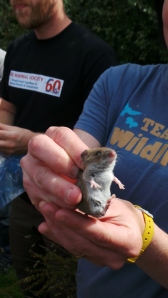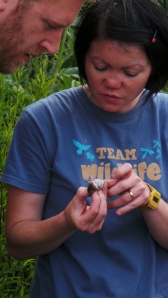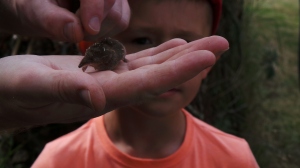The Wildfowl and Wetland Trust, in one of their booklets describe Martin Mere as offering “spectacular displays of feather and flight.” This is but one aspect of this special place, the large-scale side of it, but it possesses alongside the spectacular displays, simpler, smaller but equally special experiences for anyone interested in the natural world.
We had a long trek northwards in motorway commuter traffic to get there, but sitting in our slow-moving car with thousands of others creeping in four lanes over the Runcorn Bridge, we were content with the thought that we had a day of peace and wildlife to look forward to. Not a boring day in the office like most of those around us had to look forward to.
The flat land through which the road finally winds toward the end of our journey, was sodden with the recent heavy rain, the road covered in slime. The fields were full of leeks, cabbages and root crops, grown in the richness of the silted land. Turning into the site and we were in a different world away from the commuters, the farmers and away from reality. The noise that greeted us was the melee of calling geese and swans in their thousands all talking at once. The mere was full, hardly any water surface left to see. It was solid with ducks, geese and swan. A confusing site – where to look? Our eyes had to become acclimatised to the sheer numbers of wildfowl, the sea of confusion.

The majority of the swans were Whooper Swans with Mute and Berwick present in much smaller numbers. The Whoopers’ yellow beaks appear over-sized and over-bright, exaggerating the pure whiteness of their plumage. Their’s is the sort of white that washing powder manufacturers strive for. Pink Foot and Grey Lag Geese make up the majority of the geese and Shelduck and Pintails seemed to be the ducks of preference. Hundreds of Black Headed gulls in various stages of moult filled the gaps in between.
Looking carefully amongst these large and noisy birds we were able to spots waders, hundreds of Lapwing with smaller numbers of Grey Plovers and Golden Plovers. Larger Black Tailed Godwits and the much smaller Redshanks fed busily probing the mud with their long bills.
A short amble from the Mere is the diminutive Janet Kear Hide, which overlooks an intimate pool surrounded by small leafless trees, mostly willow and hawthorn. Here feeding stations have been set up to give close up views of the reserve’s smaller birds. Greenfinch, Goldfinch and Chaffinch dominate, feeding busily on the mixed seeds, with Great Tit and Blue Tit attracted to the peanuts in the hanging feeders. A real treat was the number of Reed Bunting using the feeding station. At Slimbridge we were excited to spot one, here there were dozens.


The finch family and tit family were also represented by rarer members, a Willow Tit and a Brambling. These were birds which a decade or so ago were frequent visitors to our garden in winter, but are now so seldom seen. A single Tree Sparrow was the only representative of the sparrows, as we did not see any House Sparrows that day.
The feeding stations here were so busy most of the time but were silenced three times, once by a group of fleeing Feral Pigeons charging through the trees pursued by a Peregrine and twice when a male Sparrow Hawk came ahunting. He reduced the Chaffinch population by one on his first visit.
Moving on to the United Utilities Hide and the Harrier Hide we passed through avenues of trees dotted with nest boxes and the ground below dotted with log piles and brash heaps, both great insect habitats. They are also useful hunting places for Wren and Dunnock.

The wind was blowing strongly, carrying cold air across the flatness of the land around this end of the site. When we opened the viewing windows our noses ran and our eyes shed cold tears. Shelduck were here in large numbers on the fingers of mud, spending their lunchtime preening.



During the afternoon we wandered across to the other side of the reserve making our way to the Ron Barker Hide. We followed paths alongside a stream, the pathways overhung by bare trees of winter. Beneath them on the verges mosses took advantage of the extra damp atmosphere and colonised any rotting stump or fallen trunk. We were surprised to see so much fungi in evidence. Each stump a garden made by nature.




We arrived at the Ron Barker hide – it was busy. Rows of birdwatchers peering through telescopes, or scopes as they would call them, the front lenses poking out into the thin cold January air. “Third bush past the gate!” “Follow the shining fence down from the red tractor!” Instructions to each other, aids to spotting a rarity.
There was so much noise across the water, reeds and farmland beyond, bird noise carried by the wind to our cold ears. We joined in the spotting and scanning and were rewarded with the sight of a Snow Goose gently landing on rough grass beyond the nearest watery expanse. Alongside the Grey Lags and Pink Foots these smooth white geese appear delicate. They appear whiter than the multitude of swans bustling around them.
A Marsh Harrier was hunting on the edge of the farmland, flying low over the tall grasses and occasionally dropping down appearing minutes later with no sign of prey. As he followed a fence line he spooked a Hen Harrier, much smaller and slender. They hunted almost together for a while but occasionally the larger Marsh Harrier dived at the Hen Harrier putting it down. We watched this spectacle for an enjoyable ten minutes before they moved in front of the dropping sun, which hid them from our prying eyes.
We just had time left for another perusal of the Mere before the light defeated us. The swans now looked ghostly in the pink-tinted water. they were joined by more and more geese flying in to roost. The day finished with a real show. A Short Eared Owl was quartering the marshland abutting the mere, hunting voles with a periodic hover, his colours made richer in the late afternoon light. It is sightings like these that make the reserves of the Wildfowl and Wetland Trust so special.






































































































































